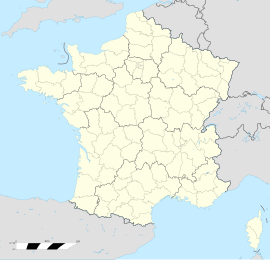Saint-Hippolyte-du-Fort
Appearance
Saint-Hippolyte-du-Fort
Sent Ipolit (Occitan) | |
|---|---|
 The temple in Saint-Hippolyte-du-Fort | |
| Coordinates: 43°58′00″N 3°51′24″E / 43.9667°N 3.8567°E | |
| Country | France |
| Region | Occitania |
| Department | Gard |
| Arrondissement | Le Vigan |
| Canton | Le Vigan |
| Government | |
| • Mayor (2020–2026) | Bruno Olivieri[1] |
Area 1 | 29.38 km2 (11.34 sq mi) |
| Population (2021)[2] | 3,747 |
| • Density | 130/km2 (330/sq mi) |
| Time zone | UTC+01:00 (CET) |
| • Summer (DST) | UTC+02:00 (CEST) |
| INSEE/Postal code | 30263 /30170 |
| Elevation | 135–547 m (443–1,795 ft) (avg. 170 m or 560 ft) |
| 1 French Land Register data, which excludes lakes, ponds, glaciers > 1 km2 (0.386 sq mi or 247 acres) and river estuaries. | |
Saint-Hippolyte-du-Fort (French: [sɛ̃t‿ipɔlit dy fɔʁ]; Occitan: Sent Ipolit; lit. 'Saint Hippolytus [of the Fort]') is a commune in the Gard department, Occitania, southern France. The town has a silk museum[3] and barracks.[4]
Population
[edit]| Year | Pop. | ±% p.a. |
|---|---|---|
| 1968 | 3,547 | — |
| 1975 | 3,461 | −0.35% |
| 1982 | 3,400 | −0.25% |
| 1990 | 3,515 | +0.42% |
| 1999 | 3,391 | −0.40% |
| 2007 | 3,732 | +1.20% |
| 2012 | 3,857 | +0.66% |
| 2017 | 3,939 | +0.42% |
| Source: INSEE[5] | ||
In literature
[edit]A book titled Divided Loyalties described life in the commune and the area during the Second World War as experienced by Janet Teissier du Cros and family.[6]
See also
[edit]References
[edit]- ^ "Répertoire national des élus: les maires". data.gouv.fr, Plateforme ouverte des données publiques françaises (in French). 2 December 2020.
- ^ "Populations légales 2021" (in French). The National Institute of Statistics and Economic Studies. 28 December 2023.
- ^ "The Silk Museum | Office de Tourisme du Piémont Cévenol". www.piemont-cevenol-tourisme.com. Archived from the original on 23 January 2014.
- ^ Nichol, John; Rennell, Tony (2008). Home Run: Escape from Nazi Europe. Penguin Adult. ISBN 9780141024196. OCLC 192027039.
- ^ Population en historique depuis 1968, INSEE
- ^ Stafford, Jean (10 September 1964). "Living through the War". The New York Review of Books. Retrieved 27 July 2018.
Wikimedia Commons has media related to Saint-Hippolyte-du-Fort.



